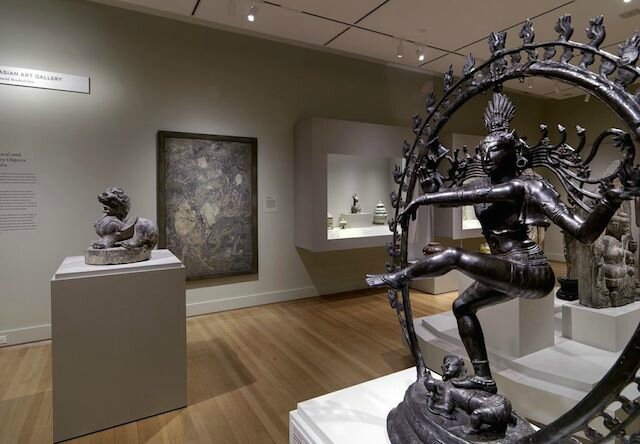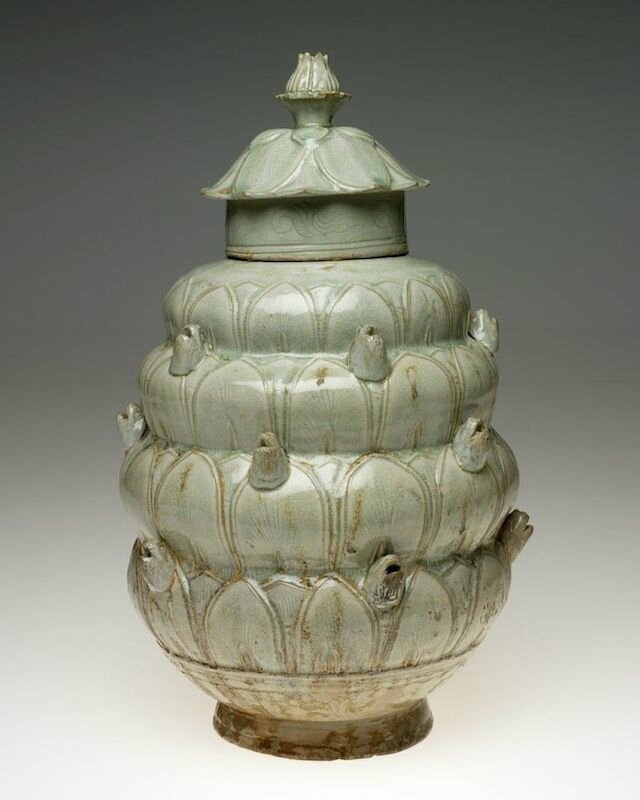New galleries for ancient Egyptian art, Asian art, costume and textiles open at The RISD Museum
Gallery view, RISD Museum
PROVIDENCE, RI.- The RISD Museum announces the completion of the $8.4 million renovation of its 1926 Eliza G. Radeke Building with the opening of newly renovated galleries for ancient Egyptian art and Asian art, and new spaces for costume and textiles. These eight revitalized sixth-floor galleries opened to the public on June 13, 2014.
“Museums, art, and historic sites are all the backbone of our creative economy,” says Governor Lincoln Chafee, who joins the Museum in commemorating the opening with a ribbon-cutting ceremony. “When you look at what the arts can offer the community and our quality of life, it makes a lot of sense to invest in this important area. It is our goal to make Rhode Island the ‘State of the Arts.’”
Part of the Rhode Island School of Design (RISD), the country’s top college of art and design, the RISD Museum serves more than 100,000 visitors a year. The seven-year Radeke Restoration Project transformed the Museum’s central building, one of five interconnected structures, and reimagined the visitor experience of its internationally acclaimed collection of works of art and design. Initiated in 2006 by a Challenge Grant from the National Endowment for the Humanities, the project addressed three public floors of galleries and teaching spaces in four phases.
“The completion of the Radeke Restoration Project is a signal achievement for the RISD Museum and has been made possible through the extraordinary generosity of local and national philanthropy,” says John W. Smith, Director of the RISD Museum. “Eliza Greene Radeke, in whose honor these galleries were dedicated in 1926, was one of RISD’s most visionary leaders; during her long tenure as RISD’s president, she led the Museum into a transformative period of expansion and excellence. Throughout this project, our goal has been not only restoring the original architectural integrity of the Radeke building, but to ensure the RISD Museum’s relevance as a vital center for art and design for 21st-century audiences. The project’s final phase, the newly restored and resequenced sixth-floor galleries, reflect the RISD Museum’s unique position as part of a creative community. Deeply rooted in the context of an art and design school and informed by new research and analysis, the galleries offer a unique point of access to cultural history.”
Sarah Ganz Blythe, Director of Education, adds, “Working within a community of makers with deep expertise and knowledge, the RISD Museum’s new interpretation continues a commitment to highlighting how and why art and design is made and seeks to cultivate an active engagement with all aspects of the creative process. Encountering novel objects in museums often elicits questions such as ‘How was that made?’ Visitors to the new galleries can learn how the scarcity of wood in ancient Egypt affected its use as an artistic material, or how Japanese lacquer differs from that of other cultures, or how the Chinese developed porcelain using a secret formula that took Europeans centuries to replicate. Art in the new galleries is arranged in such a way that the role of the artist and the act of making take center stage.”
RISD Museum gallery New Look Old Favorites, Asian Textiles.
Japanese, Japan. Nō Theater Costume (Karaori), late 18th-early 19th century. Silk, gold-leaf gilt paper; twill weave, continuous supplementary weft, discontinuous supplementary-weft patterning. Center back: 147.3 cm (58 inches). Gift of Miss Lucy T. Aldrich 35.474. Photo courtesy RISD Museum of Art
Costumes and textiles drawn from the Museum’s significant but infrequently seen collection are now on view in the Angelo Donghia Costume and Textiles Gallery and Study Center. Dramatic installations in expansive gallery cases and large display drawers juxtapose textiles and garments from different cultures, times periods, and media—illustrating the ebb and flow of ideas, aesthetics, and techniques integral to the history of design, craftsmanship, trade, culture, and current artistic practice.
“For the first time in the Museum’s history, we can offer visitors multiple opportunities to explore the riches of this exciting collection,” says Kate Irvin, Curator of Costumes and Textiles.
Throughout the galleries, object labels and audio recordings of artists and scholars explore the sources and properties of materials, and communicate the context of cross-cultural trade and systems of belief. The function, cultural importance, and life-history of objects—from large stone sculptures to exquisite woodblock prints—is brought to life by examination of the makers’ materials, techniques, and training.
Gallery view, RISD Museum
Junya Watanabe, designer Japanese, b. 1961, Comme des Garçons, design label, Japanese, Dress, 2008. Cotton plain weave, printed; rayon and polyester braid embellishment. Center back length: 153.7 cm (60 1/2 inches).Museum Purchase 2009.61.1. Photo courtesy RISD Museum of Art
“It’s a more focused look,” says Gina Borromeo, Curator of Ancient Art. “It’s a multicultural world up there—through time, through space, using the lens of medium. It’s been fun, looking at the different collections and breaking out the ways of thinking about making. The big excitement is that is gives visitors a chance to revisit old favorites—the Buddha and mummy, for example—these are central figures that may seem familiar, but now we’re offering more. For the first time, the coffin of the Egyptian priest Nesmin can be seen open, giving visitors an intimate look at the underside of the lid and the image of the goddess Nut on the inside of the coffin base. Or learn about the beautiful inscriptions on the Buddha that we just discovered and translated.”
The significance of several visitor favorites becomes even more apparent when presented in cultural context: the mummy of Nesmin (250 BCE) is surrounded by ancient Egyptian tomb objects that highlight social stature and accompany the deceased on the journey into the afterlife; adjacent displays of artists’ models illustrate the skill and fine craftsmanship that went into such sacred objects. A gallery of Asian devotional art invites meditative contemplation, drawing visitors toward a renovated corner gallery in which the monumental Dainichi Nyorai Buddha (ca. 1150-1200) presides in seated serenity. A large walk-around center case invites a closer look at the Museum’s exceptional Japanese bridal palanquin, conserved in 2010 with the assistance of the Sumitomo Foundation of Japan and now shown alongside Asian objects of exquisite craftsmanship such as silk Japanese robes woven with brilliant gold, prized Chinese porcelains, and Islamic lacquerware.
Museum Technician Michael Owen (left) and Lead Museum Technician Laura Ostrander. Photo by Erik Gould, RISD Museum Photographer.
Egyptian, From Meir. Model of a Funerary Boat, 2100-1900 BCE. Wood (probably sycamore) linen, and paint. Height: 57.2 cm (22 1/2 inches). Gift of Mrs. Gustav Radeke 14.491. Photo courtesy RISD Museum of Art
Egyptian. Sculptor’s Model of a Striding King, 305-250 BCE. Limestone, traces of paint, 24.7 x 8.3 x 8.9 cm (9 3/4 x 3 1/4 x 3 1/2 inches). Helen M. Danforth Acquisition Fund 2014.2. Photo courtesy RISD Museum of Art
Egyptian, Roman Period, Portrait of a Man, ca. 260 CE. Mary B. Jackson Fund. Photo courtesy RISD Museum of Art
Asian; Japanese, Dainichi Nyorai Buddha, Cryptomeria wood, 294.6 x 212.1 x 165.1 cm (116 x 83 1/2 x 65 inches). Museum Appropriation Fund 36.015. Photo courtesy RISD Museum of Art
Japanese, Japan. Palanquin (norimono) with Tokugawa and Ichijo Crests, late 18th Century- first half of the 19th Century. Black lacquered wood with gold paint and incised metal fittings; ink and color on paper, 134.6 x 130.8 cm (53 x 51 1/2 inches). Gift of Brown University 2004.113. Photo courtesy RISD Museum of Art
Gallery view, RISD Museum.
Japanese, Palanquin with Tokugawa and Ichijo crests, late 18th century-first half of the 19th century. Gift of Brown University. Photo courtesy RISD Museum of Art
Gallery view, RISD Museum.
Indian, India; Tamil Nadu, Shiva Nataraja, the King of Dance, 16th Century. Bronze. Height: 117.5 cm (46 1/4 inches). Museum Appropriation Fund 33.026. Photo courtesy RISD Museum of Art
Tibetan, Seated Buddha, 1662. Bequest of John M. Crawford Jr. Photo courtesy RISD Museum of Art
Chinese, Covered Jar, 900–1100 CE, Yue ware. Height: 36.2 cm (14 1/4 inches).Museum Works of Art Fund 43.149. Photo courtesy RISD Museum of Art

/https%3A%2F%2Fprofilepics.canalblog.com%2Fprofilepics%2F1%2F0%2F100183.jpg)
/https%3A%2F%2Fstorage.canalblog.com%2F03%2F02%2F119589%2F96711876_o.jpg)
/https%3A%2F%2Fstorage.canalblog.com%2F11%2F31%2F119589%2F94773502_o.jpg)
/https%3A%2F%2Fstorage.canalblog.com%2F20%2F83%2F119589%2F94772815_o.jpg)
/https%3A%2F%2Fstorage.canalblog.com%2F26%2F72%2F119589%2F75604929_o.jpg)
/https%3A%2F%2Fstorage.canalblog.com%2F59%2F60%2F119589%2F26458628_o.jpg)



















/http%3A%2F%2Fstorage.canalblog.com%2F95%2F20%2F119589%2F113065455_o.jpg)
/image%2F1371349%2F20240418%2Fob_ac5c4c_telechargement.jpg)
/image%2F1371349%2F20240418%2Fob_709b64_304-1.jpg)
/image%2F1371349%2F20240418%2Fob_22f67e_303-1.jpg)